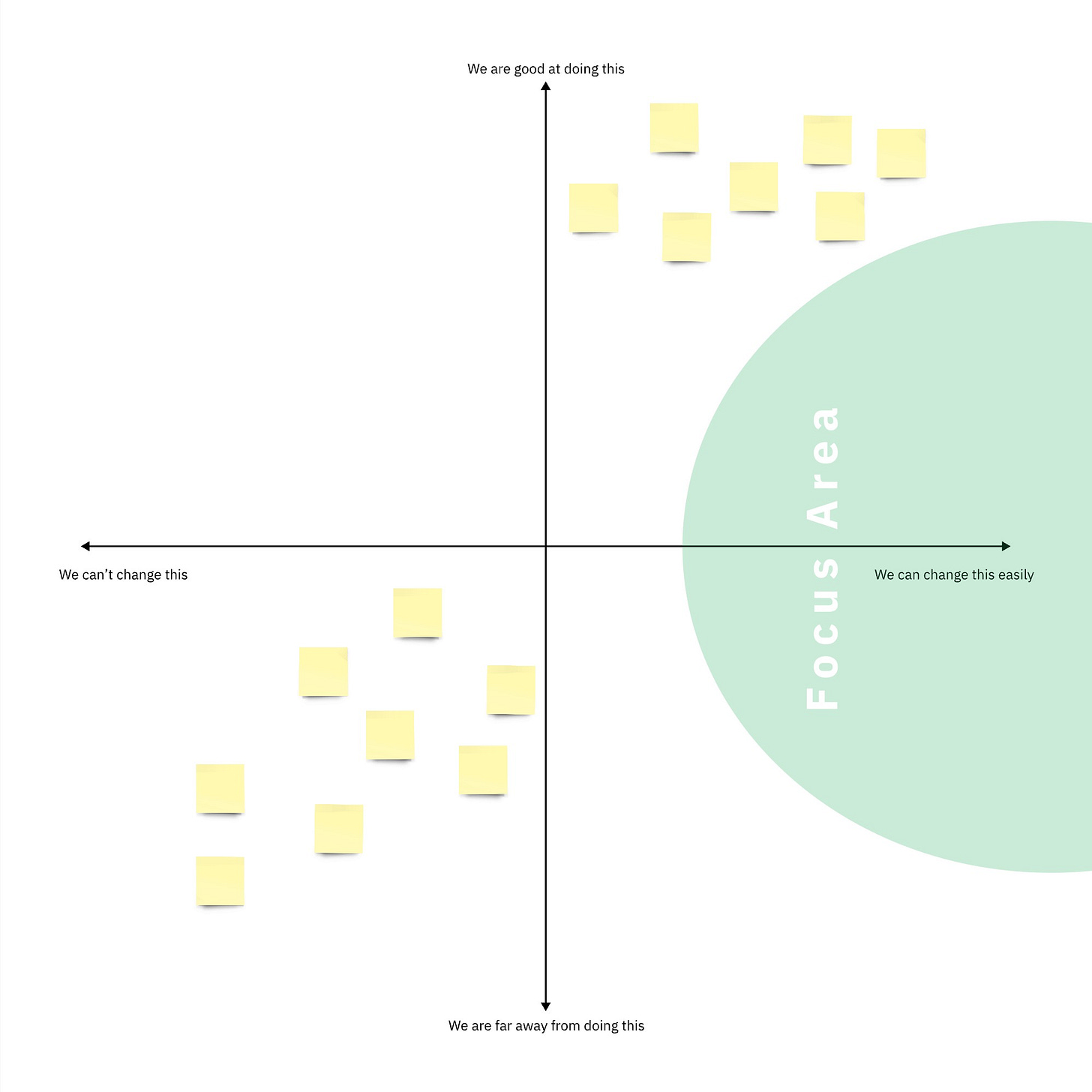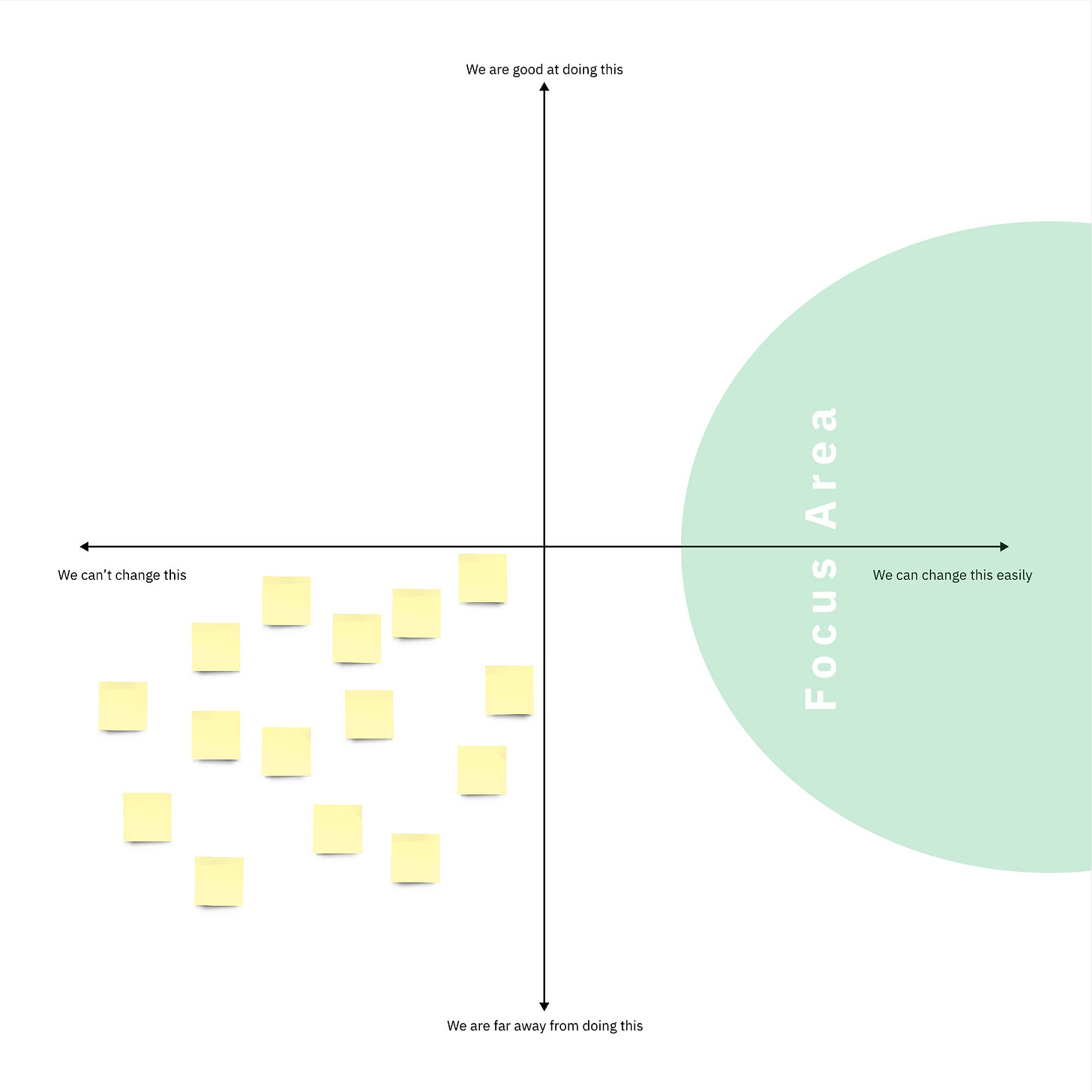How to Start Transforming Your Team
A workshop format for product teams to identify realistic improvement areas
After seeing too many times product teams who struggle heavily between “We need to get out of this mess“ and “We are not allowed to change anything,“ I designed a workshop to support teams in adopting product model tactics. This workshop is a tool to help them break free from unproductive discussions and take actionable steps to improve their product development processes. You can access the Miro template directly or read on for a more in-depth description.
Team Retrospectives are going nowhere?
How often do you come out of a retrospective or any other team process discussion and feel that nothing substantial was achieved? I frequently see sessions focusing more on complaining than on improving, and the verdict is more or less, “It’s outside of the team’s control — we can’t do anything.” And I don’t blame the teams. Many things are outside their control, and actionable improvements are hard to identify.
At the same time, everybody who is at least slightly interested in the software and product industry is surrounded by endless material and tips on how to be more “agile,” “empowered,” or “product-led.” Unfortunately, these approaches might seem out of reach and unrealistic for many teams. So the question is: “Where do we start to improve?”
Product leaders echo these sentiments. If you’re in a leadership position, you might think or even say, “If only my teams would...”. But, as you know, it’s rarely that simple. The question of “Where do we start?” quickly leads to endless discussions and frustration on all sides and, therefore, blocks any action.
A few factors are central to improvement. The team needs to know what methods and tactics make sense to improve. Another aspect many teams don’t tangibly express is their level of influence. Two questions arise: How capable is a team currently at doing X, and is X even changeable for the team?
The workshop
With this in mind, I've designed a one-hour workshop to enable teams to find the right tactics to improve and break free from the cycle of endless discussions and low progress. I recommend conducting it with the entire cross-functional team. If that’s not feasible, the product trio (Product, Engineering, Design) would be another option. Product leaders can guide this exercise for their teams, but it’s crucial to trust the team's honest input without interfering or trying to pressure the team in a specific direction.
You can find the ready-to-start workshop template with an example on Miroverse.
The Miro Board includes an example of the workshop with some facilitation tips. I won’t repeat every detail of the board here. It will be easier to follow the example to understand the details of the workshop.
The workshop follows roughly the structure of the product operation model described in Marty Cagan’s Transformed. You don’t need to read the book to run this workshop. However, the book would be the most direct way to dive deeper into certain concepts. You can also get an impression of the book at my visual overview.
The workshop is based on 15 team tactics divided into 5 aspects of product development: Product Teams, Product Strategy, Product Discovery, Product Delivery, and Product Culture. These tactics are designed to address common challenges in product development and provide practical solutions. If a tactic doesn’t feel applicable, feel free to remove it before heading into the workshop.
With its four simple steps, the workshop can efficiently be run as a retrospective or at a team event.
The team reflects on how good they are at each given tactic
The team defines how easy it is for them to make progress at each tactic
The team picks tactics to improve on
The team defines action points and how to follow up
The critical point is that the team self-determines its abilities and reflects on how easy it is to develop those skills further. Often, teams get stuck by wanting to change some deep cultural behaviors without having the needed trust and basics in place. The sequence of change is different for every environment. For example, Team A might face resistance regarding data collection but can deploy frequently. In another case, Team B has good instrumentation but is restricted from releasing anything independently.
Make sure to define clear actions
Of course, the most important outcome of the workshop is the actions resulting from the exercise. Make sure to reduce your action points. After the third step, you might see a lot of potential, but choose one or two to establish focus. Nothing is more frustrating than getting out of the workshop and not following through.
It is important to define one shepherd for an action item. This doesn’t mean this person is solely responsible for any result, but this person needs to be the owner who ensures the actions don’t fall through in everyday work.
If the team has trouble coming up with actions, feel free to extract this part into a separate ideation session. In this session, you generate many ideas and then narrow down the most promising.
After the Workshop
You can run this workshop once and gain a first direction. However, it makes sense to revisit it in intervals to iterate and continuously improve to achieve its full potential.
One aspect of the follow-up is to reflect on co-movement for the tactics. It is common for a team to improve on specific tactics. In parallel, other tactics become more accessible. For example, if a team builds trust by showing its product impact to its leadership and stakeholders, it can gradually shift the conversation to more outcome-centric topics.
But as your environment changes, your map will also change over time. Be aware that this might result in some improvements as well as setbacks. You already know that not everything is in the team's power.
Unexpected results
After the team mapped all tactics, there might be situations indicating that nothing seems within reach. Let’s explore a few patterns.
We are great, but …
Every tactic the team thinks they can change is already in great shape, but everything else seems non-negotiable. One cluster is at the top right, and one is at the bottom left.
The first step is to look again at things out of reach. Why is that? Is there a trust issue connected? Is your organizational structure working against this? For example, discovery is done by a separate team. Try to find some small steps you can take to improve. For the discovery example, you could start to interact with the discovery team more regularly and share your learnings or help prototyping.
Another approach is to show the matrix to your leaders and ask them where they disagree. They might see an area for improvement where you thought you were world-class. You can invest there to build up more trust and credibility. Even better, they can identify an area where you thought you were not allowed to change anything and show you how.
We are not that good, but we can’t do anything about it
All tactics are stuck in the lower left corner.
This is a wicked situation. Everyone is probably pretty frustrated. The first approach is to shift all stickies to the right. What is at least a tiny bit within reach? Decompose these tactics and see if there is an aspect you can change.
Can you start to communicate and collaborate better within the team? Can you begin to take the first steps to improving your delivery? Even if you cannot deploy independently, you might find space for improvement in your integration methods. Or even if you can’t talk to customers and users, is there any other source within the company or outside the company where you can gather user insights (Customer Support, Sales, User Forums, …)? Find a slight improvement and start to communicate progress to your leaders, to show that you will be ready for more responsibilities soon.
Could you try to find someone outside of your team? This might be your leader or someone else who wants to support you and discuss where they see potential. The outsider’s perspective can give a new angle.
Get started
Remember, the main goal of this workshop is to get unstuck and out of your retro limbo. Gain back some agency by having a motivating discussion about what you can actually influence. You might remember I wrote about this workshop format a few weeks ago. I consciously slimed this version down to fit into a one-hour format.
Once more, The Miro board
Need a facilitator?
I’m happy to run this workshop for your team. The benefits when I’m running? You get a deep intro on the different tactics. I support the team in strategizing about what to approach first and defining actions and measurements that worked for other teams. All while you can fully concentrate on participating in the workshop.
Sounds good? Get in touch.








Thanks so much for sharing this. I'm currently doing the PM wheel and future self exercise (thanks to Petra Wille!) with each PM in my area, but this exercise may add the much-needed TEAM dimension for continuous improvement.
I do struggle with the fact that we're currently so far away from "the Product model" that landing the five categories and related concepts to be able to work with them will require significant pre-work. Maybe that's a common complexity with other product teams that require improvement. But don't think this is a blocker and am curious to see how this plays out. Thanks again! And will update, if relevant. ;)
This is great, thanks for sharing.
I've had some success with estuarine mapping by Dave Snowden which goes after energy and time required to make a change.
https://cynefin.io/wiki/Estuarine_framework